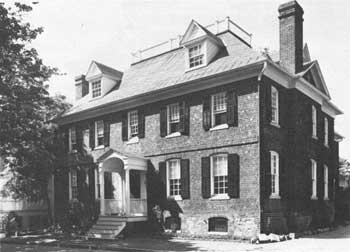







Survey of
Historic Sites and Buildings
 |
Peggy Stewart House (aka Rutland-Jenifer-Stone House) Maryland |
|
| ||
This residence is also known as the Rutland-Jenifer-Stone House, the Rutland-Peggy Stewart House, and the Rutland-Stewart-Stone House. Daniel of St. Thomas Jenifer owned it at three different times, but it cannot be determined if he ever lived in it.
Thomas Rutland constructed the building some time between 1761 and 1764. Jenifer first acquired it in January 1772 and 6 months later sold it to Anthony Stewart, an Annapolis merchant. In 1774 Revolutionaries forced Stewart to burn his ship, the Peggy Stewart, when he attempted to land a cargo of tea on which he had paid taxes. Five years later, he fled to England and Mrs. Stewart sold the house back to Jenifer, who then owned it for a 4-year period before selling it in 1783 to Thomas Stone, signer of the Declaration of Independence, who occupied it while in the city. When Stone died 4 years later, Jenifer again purchased the property, which he held until his death in 1790.
The rectangular Georgian brick house, which is five bays wide and three deep, is in excellent condition, but over the years both the exterior and the interior have been substantially modified. Its 2-1/2 stories rest on an elevated basement. At the time of a major alteration in 1894, the gable roof was replaced by the present hipped roof, which has a cutoff deck and balustrade, and the end chimneys were rebuilt in their present form. Two gabled dormers are located at the front of the roof, and one at each side. Highlighting the ends of the house are central pavilions, which have triangular pediments and round center windows. The chimneys cut through the front corners of the pediments. A wooden box cornice with frieze board below extends around the eaves. A large wing at the rear is a later addition.
 |
| Peggy Stewart House. (National Park Service (Boucher, 1964).) |
The front, or north, facade is comprised of all-header bond and the sides of English bond. Basement and first-story windows are topped by segmental arches; those on the second floor, by flat ones. The sills are of stone. Louvered shutters flank the first- and second-floor windows. The front entrance, sheltered by a small modern wooden porch with a triangular pediment, has a paneled door that is surmounted by a rectangular, glazed transom.
The interior has been extensively remodeled in recent times. The original portion of the house, excluding the rear addition, has a center-hall floor plan. The stairs are set against the east wall, and a large living room occupies the east side of the house. A parlor and dining room are situated to the west of the hall. Five bedrooms are located upstairs. Only one fireplace, on the second floor, retains its original mantel.
The privately owned residence, part of Colonial Annapolis Historic District, is not open to the public.
 |
 |
http://www.cr.nps.gov/history/online_books/constitution/site11.htm
Last Updated: 29-Jul-2004